Intel Core 2 Duo E6300 & E6400: Tremendous Value Through Overclocking
by Anand Lal Shimpi on July 26, 2006 8:17 AM EST- Posted in
- CPUs
Application Performance using SYSMark 2004 SE
We'll kick off our look at general application performance with SYSMark 2004 SE and as always, we'll look at the overall score as well as the scores in each of the two suites - Internet Content Creation and Office productivity.
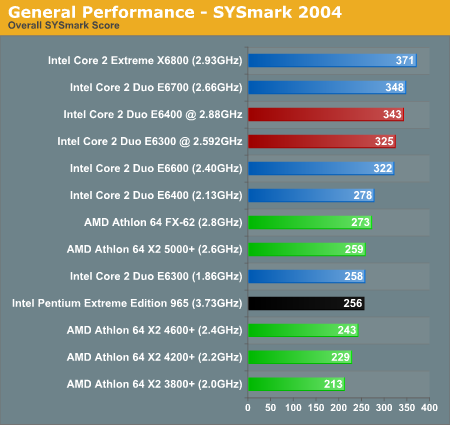
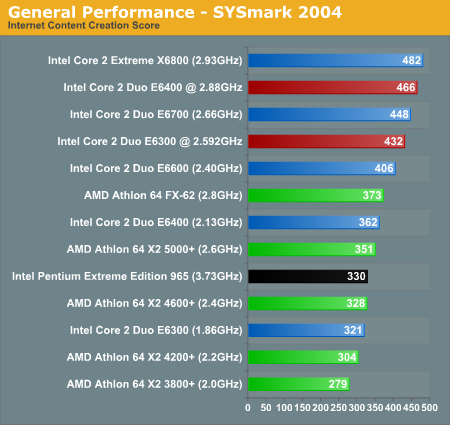
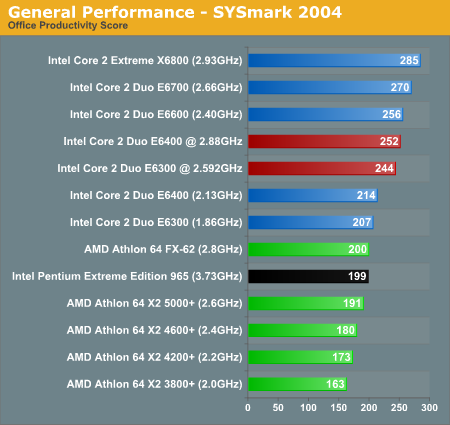
The applications tested by SYSmark 2004 cover the vast majority of the modern computing spectrum. Everything from multimedia to office to multitasking performance is included, and while not every application will show a substantial performance increase with a faster processor, the overall performance spread among the tested CPUs is almost 75%. If you routinely do a lot of computationally intensive work on your system (surfing the web and writing email generally don't count), there's no question that you will see a substantial difference between the fastest and slowest systems we're testing.
Our first look at the E6300/E6400 with overclocking generates some interesting results. There has been speculation that one of the reasons Core 2 Duo chips perform so well is that they have so much L2 cache. Dropping from 4 MB to 2 MB of cache does hurt performance a bit, but with a little bit of overclocking both of our budget Core 2 Duo chips perform very well. The net loss appears to be about 200 MHz, so the 2.88 GHz E6400 roughly equals the 2.66 GHz E6700, and the 2.59 GHz E6300 roughly matches the 2.4 GHz E6600. Drilling down into the individual benchmark results for SYSmark 2004, the impact of the reduced cache is more apparent in Office Productivity applications than it is in the Internet Content Creation results, but the 2MB Core 2 chips preform respectably regardless of the application being tested. Perhaps a Core 2 with 1MB or less of L2 wouldn't perform all that well, but since those parts don't exist there's no reason to worry about hypothetical bottlenecks right now.
Switching over to the AMD versus Intel comparisons, the E6300 and E6400 already compete very well, and once we throw in overclocking they are basically out of reach of any of the AM2 processors -- with or without overclocking. In overall score, the overclocked E6300 is almost 20% faster than the FX-62. A 20% overclock of the FX-62 (3.33 GHz) might close the gap, but it would certainly require more than stock air cooling, and it doesn't change the fact that we are able to get extremely good performance out of Intel's $180-$220 parts.
The individual SYSMark 2004 SE scores are graphed below if you're interested; the data is used in calculating the overall scores we've already discussed above:
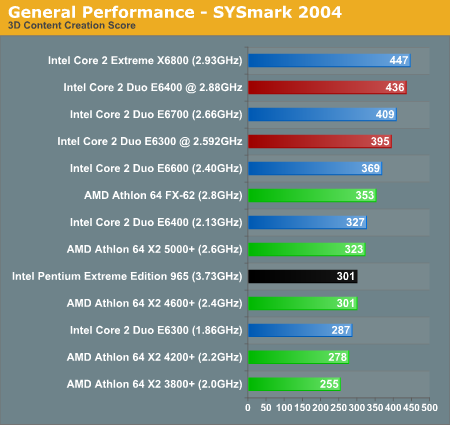
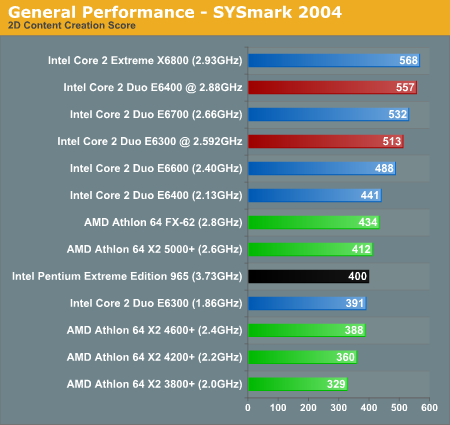

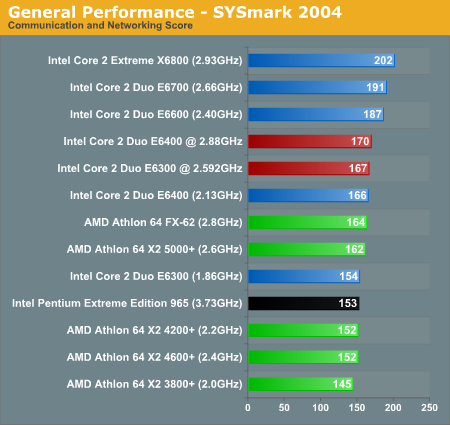
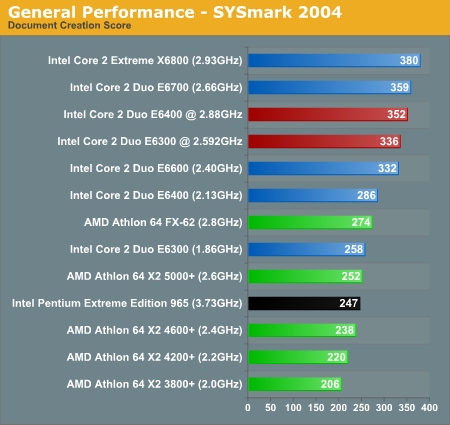
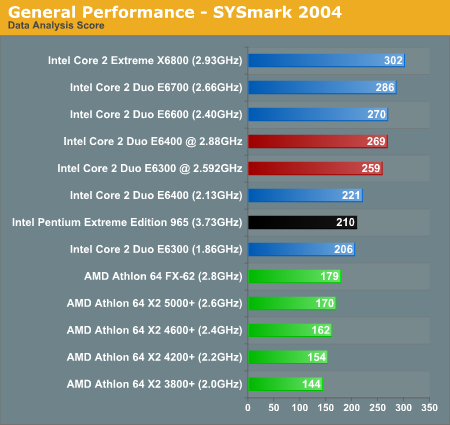










137 Comments
View All Comments
bob661 - Wednesday, July 26, 2006 - link
I wonder if motherboard prices fore the Conroe's will go down once Nvidia and ATI start making chipsets for those CPU's.Sunrise089 - Wednesday, July 26, 2006 - link
I'm sure they will, and I will myself switch to Conroe when prices drop enough.For now though, there seem to be many questions left unanswered: how much these chips actually overclock (seems both that low-end parts do not overclock nearly as well as high-end, which is very different from X2s, and it also seems that not everyone is matching AT's overclock results), how expensive of a motherboard you need to get a good overclock (seems like a very expensive one, very different from X2s once again, where a cheap DFI Infinity or ePox motherboard overclocks basically as well as an expensive ASUS), and my above point of whether or not Conroe is actually faster dollar for dollar at the X2 5000+ level and below (I suspect it isn't). These articles need to be adressing these above points, rather than pointing out what we already understand - yes Conroe is faster clock for clock.
Anandtech is doing something very dangerous by putting certain chips together in people's minds. The X2 3800+ and E6300 are NOT competitors, the AMD part is probably $150 cheaper after motherboard purchase. But since AT is placing ideas in people's heads about the Intel part being so much faster, when Conroe is available for purchase and the very possible price-gouging takes place, people are still going to buy them thanks to sloppy reporting, since they are now convinced that Conroe destroys AMD's equivilent chips by such a large degree, and therefore paying $250 for a E6300 must still be a good choice. If AT were instead comparing the E6300 to a X2 5000+, buyers would see the true performance difference, and then be able to figure out that if the Intel part is at all above MSRP it isn't a good deal with these motherboard prices.
dev0lution - Wednesday, July 26, 2006 - link
Again, where are you getting that? It's an AM2 AMD vs Conroe comparison, so again, you're point about motherboard cost isn't as relevant as you make it out to be. Granted, you'll pay more this week for a Conroe-capable motherboard and the E6300 is still approximately $31 more but it's not the dramatic price gap that would elevate the 5000+ parts to be equivalent.
It would have been nice to see a 939 vs. Conroe comparison, but even that's not apples to apples since the 4800+ is rated at 110w on AMD's site vs. 65w for the Conroes. Personally, sitting in a heatwave I'm beginning to appreciate how much a s939 4000+ throws off.
dev0lution - Wednesday, July 26, 2006 - link
And check the article again Mr. Attention-to-detail. An E6300 isn't $250, it's $183. Guess you skipped that part once you started foaming at the mouth....Sunrise089 - Wednesday, July 26, 2006 - link
Please read more carefully. I was talking about buying a post price-gouging E6300, and therefore making up a higher price it might go for. I think it was quite clear.theteamaqua - Wednesday, July 26, 2006 - link
meh no where near extremeES5 stepping B1 (retail is stepping6 , B2) can go much higher
E6400 : 8x480
E6300: 7x500
this is weak OCing
johnsonx - Wednesday, July 26, 2006 - link
Everyone knows AMD processors have always been, and will always be, far superior to the crap from Intel. Any article suggesting otherwise is clear evidence of pro-Intel bias, that indeed you all get weekly checks from Intel for the favorable press. The reality is that most Intel processors really don't even work at all; all the supposed PC's sold with Intel processors secretly use AMD processors instead, but again Intel pays off the companies to say they're Intel Inside. Intel has an endless supply of money because of their unfair business practices and the Magic Money Fairy.johnsonx - Friday, July 28, 2006 - link
hey, also, why did y'all mod me down to zero on that? come on, it was funny! at least a little funny? worth a chuckle for everyone but coldpower?johnsonx - Friday, July 28, 2006 - link
I daresay I got quite a laugh out of coldpower's response(s) to my little attempt at satire.johnsonx - Friday, July 28, 2006 - link
by the way, coldpower, I didn't include the silly /sarcasm tag because I thought it would be far less funny (just plain stupid even) if I did. The idea was to start off sounding rather fanboy-ish but potentially serious, head towards the deep-end, and then go completely into tin-foil-hat territory. I was actually going to make it far longer and more complicated, probably tie in to the Masons somehow, but I had other things to do so I just wound it up quick with the 'Magic Money Fairy' bit.Surely I thought anyone I got on the hook would have wiggled off around the time I claimed that most 'Intel-Inside' PC's actually had AMD chips in them...